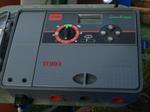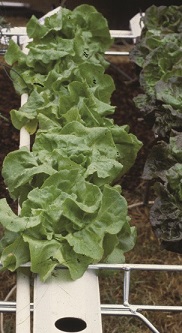Online Horticultural Techology Course.
Learn about and Apply Modern technology to Horticulture
50% of the course is specifically devoted to horticultural technology.
- The Core Units cover: Introduction to Plants, Plant Culture, Soils and Nutrition, Plant Identification and Use, Propagation & Pests, Diseases and Weeds.
- The Stream Units involve three further modules: Hydroponics I, Hydroponics II and Plant Breeding.
CORE UNITS

Students must complete and pass all of these core units. (Note: each core unit is significantly shorter in duration than each of the stream units)
Introduction to plants
The purpose of this study area is to explain the binomial system of plant classification and demonstrate identification of plant species through the ability of using botanical descriptions for leaf shapes and flowers.
Objectives
- Describe the relevant identifying physical features of flowering ornamental plants.
- Demonstrate how to use prescribed reference books and other resources to gain relevant information.
- Dissect, draw and label two different flowers.
- Collect and identify the shapes of different leaves.
- Demonstrate how to identify between family, genus, species, variety and cultivar.
Plant culture
The purpose of this study area is to demonstrate the ability to care for plants so as to maintain optimum growth and health while considering pruning, planting, and irrigation.
Objectives
- Describe how to prune different plants.
- Demonstrate how to cut wood correctly, on the correct angle and section of the stem.
- Describe how to plant a plant.
- Demonstrate an awareness of different irrigation equipment, sprinklers, pumps and turf systems available by listing their comparative advantages and disadvantages.
- Demonstrate competence in selecting an appropriate irrigation system for a garden, explaining why that system would be preferred.
- Define water pressure and flow rate and how to calculate each.
- Explain the need for regular maintenance of garden tools and equipment.
- List factors that should be considered when comparing types of machinery for use in garden maintenance.
Soils and plant nutrition
The purpose of this study area is to provide students with the skills and knowledge to identify, work with, and improve the soil condition and potting mixes, and to evaluate fertilisers for use in landscape jobs to maximize plant growth.
Objectives
- Describe the soil types commonly found in plant culture in terms of texture, structure and water-holding and nutrient holding capacity.
- Describe methods of improving soil structure, infiltration rate, water holding capacity, drainage and aeration.
- List the elements essential for plant growth.
- Diagnose the major nutrient deficiencies that occur in ornamental plants and prescribe treatment practices.
- Describe soil pH and its importance in plant nutrition.
- Describe the process by which salting occurs and how to minimise its effect.
- Conduct simple inexpensive tests on three different potting mixes and report accordingly.
- Describe suitable soil mixes for container growing of five different types of plants.
- List a range of both natural and artificial fertilizers.
- Describe fertilizer programs to be used in five different situations with ornamental plants.
Introductory propagation
The purpose of this study area is to improve the student's understanding of propagation techniques with particular emphasis on cuttings and seeds. Other industry techniques such as grafting and budding are also explained.
Objectives
- Demonstrate propagation of six (6) different plants by cuttings and three from seed.
- Construct a simple inexpensive cold frame.
- Mix and use a propagation media suited to propagating both seed and cuttings.
- Describe the method and time of year used to propagate different plant varieties.
- Describe and demonstrate the steps in preparing and executing a variety of grafts and one budding technique.
- Explain the reasons why budding or grafting are sometimes preferred propagation methods.
Identification and use of plants
The purpose of this study area is to improve the student's range of plant knowledge and the plant use in landscaping and the ornamental garden, and the appreciation of the different optimum and preferred growing conditions for different plants.
Objectives
- Select plants appropriate for growing in different climates.
- Select plants appropriate to use for shade, windbreaks, as a feature, and for various aesthetic effects.
- Categorise priorities which effect selection of plants for an ornamental garden.
- Explain the differences in the way plants perform in different microclimates within the same area.
- List and analyze the situations where plants are used.
Pests, diseases and weeds
The purpose of this study area is develop the student’s ability to identify, describe and control a variety of pests, diseases and weeds in ornamental situation, and to describe safety procedures when using agricultural chemicals.
Objectives
- Explain in general terms the principles of pest, disease and weed control and the ecological (biological) approach to such control.
- Explain the host-pathogen-environment concept.
- Describe a variety of pesticides for control of pests, diseases and weeds of ornamental plants in terms of their active constituents, application methods, timing and rates, and safety procedures.
- Photograph or prepare specimens, identify and recommend control practices for at least five insect pests of ornamental plants.
- Photograph, sketch or prepare samples, identify and recommend control practices for three non-insect ornamental plant health problems (e.g. fungal, viral, bacterial).
- Describe the major ways in which diseases (fungal, viral, bacterial and nematode) affect turf, the life cycle features that cause them to become a serious problem to turf culture and the methods available for their control.
- Identify, describe and recommend treatment for three different weed problems.
- Collect, press, mount and identify a collection of ten different weeds, and recommend chemical and non-chemical treatments which may be used to control each.
- List and compare the relative advantages and disadvantages of different weed control methods.
STREAM UNITS
Hydroponics I
There are ten lessons as follows:
- Introduction
- How a Plant Grows
- Hydroponic Systems
- Nutrition & Nutrition management
- Plant Culture
- Hydroponic Vegetable Production
- Hydroponic Cut Flower Production
- Solid Media vs Nutrient Film
- Greenhouse Operation & Management
- Special Assignment
Hydroponic Management (Hydroponics II)
There are eleven lessons as follows:
- How the Crop Plant Grows
- How to Run a Small Evaluation Trial
- Harvest and Post Harvest
- Tomatoes
- Capsicum
- Lettuce, Salad Greens and Foliage Herb Crops
- Cucurbits (Cucumber and Melons)
- Strawberries
- Roses
- Carnations
- Orchids
Plant Breeding
There are 7 lessons in this module as follows:
- The Scope and Nature of the Plant Breeding Industry
- Introduction to Genetics
- Gamete Production, Pollination and Fertilisation in Plants
- Mono Hybrid and Dihybrid Inheritance in Plants
- Systematic Botany and Floral Structures
- Practical Plant Breeding Techniques
- Current Developments in Plant Genetics
Course Duration : The entire certificate will take around 700 hours, of self paced study, to complete.
LEARNING MORE NOW CAN SAVE YOU MONEY LATER
 Some people study for the qualification; hoping that being qualified may help with getting more business or work. This may well be so, but the more important benefit from study is that you learn things that help you achieve more, and avoid problems later.
Some people study for the qualification; hoping that being qualified may help with getting more business or work. This may well be so, but the more important benefit from study is that you learn things that help you achieve more, and avoid problems later.
Consider Plant Nutrition.
With hydroponics it often becomes necessary to adjust nutrient levels in solutions for many reasons.
The effectiveness of a nutrient solution may be influenced by the plant species (and even variety), the stage of growth, the time of year (day length), the weather (number of hours of sunlight, temperature). Different species of plants have different needs in terms of different major and minor nutrients. This is especially noticeable for NPK (nitrogen, phosphorous, and potassium). For example, we know that vegetables such as cucumbers, peppers and tomatoes need more potassium, phosphorous and calcium than other types of plants. Leafy vegetables like cabbages and lettuces on the other hand need more nitrogen. As such, formulations should take into account what type of plant is being grown
It is important to be able to recognise the presence of nutrient deficiencies and toxicities in order to optimise harvests and avoid the risk of failed crops.
If the wrong nutrient is applied, or too much of the same nutrient is applied, this can result in:
- Money wasted on nutrients.
- Environmental contamination in run-to-waste systems.
- Poor growth due to toxicities or imbalances.
- Excess foliage growth leading to greater risk of pest and disease attack.
Observation of plants for signs of nutrient imbalance is still one of the best methods of recognising problems, however symptoms only appear after a nutrient imbalance has taken hold by which time sometimes it is difficult to correct them. If plants in a hydroponic system are exposed to a nutrient imbalance, then all plants will show the same symptoms - unlike with a disease where individual plants may be affected differentially.
Another problem with observations is that the same symptom e.g. tip burn, yellowing, browning may be caused by several different deficiencies or toxicities and can also be caused by other stress factors such as pollution or disease.
Keeping records of where and when symptoms first occur is very important for diagnosis, so all growers should be encouraged to do this.
Nutrient Mobility and Deficiencies
The degree to which different nutrients are mobile in the plant determines where the symptoms are likely to be seen. All nutrients are taken up by the roots from the nutrient solution and then translocated throughout the plant. However, some nutrients remain where they are deposited. Calcium, iron and boron are examples of nutrients which are weakly mobile. During deficiency symptoms are likely to be observed in younger leaves and actively growing areas of the plant whilst the nutrient balance in mature leaves remains favourable.
During deficiencies of nutrients which are highly mobile, such as potassium and nitrogen, symptoms are likely to be observed in older leaves first because mobile nutrients are sent from the roots to actively growing areas of the plant in preference to mature leaves, and they are also moved from older leaves to newer leaves.
Student Comments
" Having completed the Advanced Hydroponics Course, I have since gone on to open my own successful hydroponics retail shop, now in it's third year of trading"
- Ted
"This is the first correspondence course I have done and I have thoroughly enjoyed it and I just wanted to say a big THANK YOU. I appreciate everyone's effort in such a professionally-run organisation with seamless administration. The office staff's happy can-do attitude, their fast responses to all queries, tutor Shane Gould's quick turnaround in assignment marking and his supportive and motivational feedback and last but not least, the sound subject guides. Most importantly I hope my thanks and appreciation can be communicated to all the staff who have supported me long the way of my learning! I work full time and study on the weekend but really don't stop thinking about what gardening solution I need in order to answer my assignments every day of the week. Thank you for such a great learning experience and I cant wait to start the second half of my course!!"
- Skye
WHAT NEXT?
Register to Study - Go to “It’s Easy to Enrol” box at the top of the page and you can enrol now.
or
Get Advice – Email us at info@acsedu.co.uk OR
Use our FREE COUNSELLING SERVICE to contact a tutor
CLICK TO CONTACT US